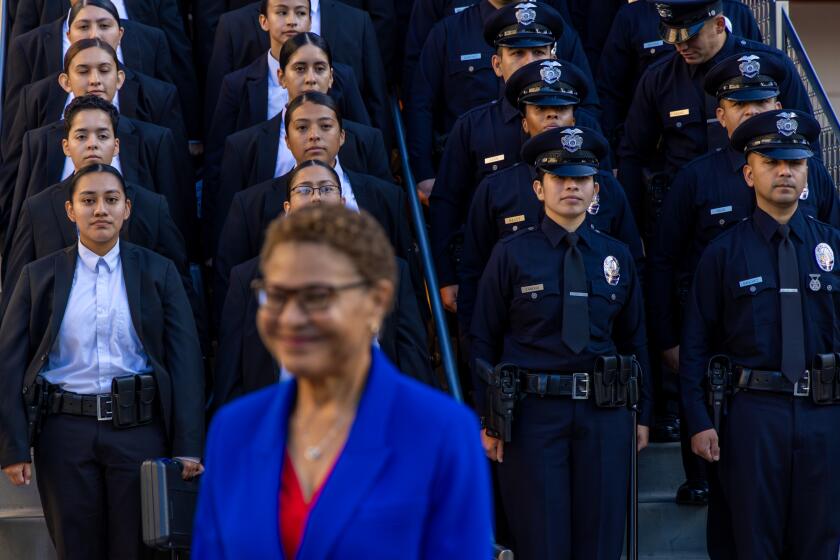Jail Informant Had Allies on Side of the Law
- Share via
VICTORVILLE — When long-time jailhouse informant Leslie White pleaded guilty in 1983 to kidnaping a stranger at gunpoint in Las Vegas, dumping him in the Mojave desert and stealing his van, nearly a dozen law enforcement officers converged on a courtroom here.
They came to ask the judge to let White go.
The officers, the judge recalled, came from the Los Angeles Police Department, the Los Angeles County and San Bernardino County sheriff’s departments, and from the Los Angeles County and San Bernardino County district attorney’s offices.
They told Superior Court Judge Leroy Simmons privately that White was a valued informant who had risked his life to put murderers in prison.
Not all law enforcement officers shared that view. Some thought White’s word was worthless and that he made up his information. But Simmons had no way of knowing that.
The officers urged the judge to release White on his own recognizance so that he could continue to inform on other criminals and so that the officers could repay White for his past services, Simmons recalled last week.
Simmons cut White’s $100,000 bail to zero pending sentencing. And White, who, at the time faced a possible 26 years in prison as a habitual criminal, walked out the courthouse door.
White, who now is at the center of a burgeoning controversy over the use of jailhouse informants, returned to Los Angeles and embarked on a small-time crime spree.
Let Go Each Time
He was caught twice--arrested for burglary and car thefts--but was let go each time, apparently at the request of the Los Angeles County district attorney’s office.
Some prosecutors from that office have engineered White’s releases from custody, even when their procedures in doing so have been questionable, according to court records and interviews with state parole officials who had custody of White.
Apprised of this information on Saturday, Richard Hecht, director of the district attorney’s branch operations, said he did not know what prompted the favors White received, but said his office will conduct an investigation into the matter.
Prosecutors appear to have been willing to give White breaks as part of their unwritten contracts with jailhouse informants--contracts that call for leniency in return for information on other inmates’ alleged crimes.
Critics of the use of jailhouse informants claim that such contracts give informants an incentive to falsely implicate others. But defenders of the practice contend that authorities can weed out information about phony confessions by looking into their own files to corroborate an informant’s account. If the informant comes up with information known only to law enforcement and the guilty criminal, this thinking goes, his account that he got the information from the guilty criminal is corroborated.
Demonstrates Skill
But with less than an hour’s work on the telephone last month, White destroyed that line of reasoning. He demonstrated to Los Angeles County sheriff’s detectives that he could easily gather enough information from law enforcement officials to fake a murder confession of a defendant he had never met. White gathered the data by phone from jail by posing as a law enforcement official.
His demonstration has prompted the Los Angeles County district attorney’s office to assign Hecht to review each case in the last decade in which the testimony of a jailhouse informant figured, and to issue strict new guidelines, requiring that “concrete evidence,” such as tape-recordings be used to corroborate an informant’s account that another inmate confessed to him.
The effect of the new guidelines is expected to be a drastic reduction in the use of informants.
In a series of interviews since his demonstration, White has acknowledged lying repeatedly to police and prosecutors about other inmates and strongly implied that he has perjured himself as a witness as well, asking a reporter at one point, “Do you know the statute of limitations on perjury?”
He has also chronicled in detail many of the favors various law enforcement officers have done for him since he became one of a small cadre of Los Angeles’ regular jailhouse informants a decade ago. Much of his account of these favors--that which is reported here--is borne out by court records or interviews with authorities.
Fails to Return
Two months after Judge Simmons released White on his own recognizance, White failed to return for his sentencing, court records show. He also failed to show up for any of his rescheduled sentencings later that year. But Simmons only once issued a warrant for White’s arrest. Then, three days after White was taken into custody, the judge let him go again.
“Typically,” the judge recalled, “(White) would stay in touch by phone with one of the detectives from our homicide squad. And I’d get a call from one of (the detectives) saying, ‘We know where he is. He’s not going anywhere. So you don’t need to issue a bench warrant.’ ”
Within days of Simmons letting White go after his arrest on the warrant for failure to appear, however, White burglarized a Whittier car wash, stole three new cars and was caught driving one of them.
He was charged with the crimes, but again was released--apparently after the case was dismissed.
Two weeks later, White was observed hot-wiring a Chevy Luv pickup truck in a parking lot in Hollywood and was arrested once more.
This time a Los Angeles Municipal judge released him on his own recognizance--apparently at the request of the district attorney’s office.
Caught With Truck
Less than a month later, White was caught driving another stolen Luv truck.
He explained in a recent interview that Luv trucks are easy to steal. Then he remarked, “If I was a citizen, I’d get (angry) at all this.”
Indeed, some of the authorities were. Prosecutors in San Bernardino and Los Angeles counties decided that it was time for White to pay for his crimes. They refiled charges in the car wash burglary and negotiated plea bargains in that case, the kidnaping and the stolen car cases.
When White finally pleaded guilty in early 1984 to all the Los Angeles charges, Superior Court Commissioner Irwin Garfinkel remarked that his hands had been tied by the district attorney’s plea bargain.
“What I am giving you in this plea bargain for one, two, three, four, five, six, seven felony crimes is no time (in prison) at all,” Garfinkel said, according to a transcript of the proceedings.
Wrong Assumption
Actually, the plea bargain called for White to be sentenced to four years in prison. But Garfinkel was apparently referring to his expectation that Judge Simmons in Victorville would eventually sentence White to a longer term, and that would effectively cancel out Garfinkel’s sentence.
“Left to my own devices,” Garfinkel told White, “you would go to prison for a lot longer.”
Then he added: “For a person of your age--I have been in this business, I don’t know, over 23 or 24 years--you have one of the worst records I have ever seen.”
White at the time was 25 years old. He was an admitted heavy intravenous user of cocaine and amphetamines and had an extensive juvenile record in Los Angeles that began at age 8 with his commitment to a state facility as incorrigible.
As an adult, he had been convicted of a number of crimes, including a series of motel robberies in the San Fernando Valley, and two kidnapings--that of a man who picked him up while hitchhiking in Long Beach and the man in the Las Vegas case, who was a door-to-door magazine salesman.
Los Angeles police also were suspicious of his involvement in a series of San Fernando Valley convenience store robberies about the time of the Las Vegas kidnaping.
Parole agent Mary Riley wrote then: “Police authorities indicate White should be classified as an undesirable informant. They feel he is an active 211 artist (211 is the Penal Code designation for robbery) and when there is a possibility he will be caught, he will contact that particular jurisdiction and turn in his partners. They further feel that all the crimes that he usually informs on, he is directly involved in.”
But other law enforcement agents were his fans. Records show that, among other things, he provided information in at least two murder cases in Los Angeles County, gave information that enabled authorities to find three bodies in San Bernardino County and testified against the leader of the Aryan Brotherhood prison gang in a prison murder case that resulted in a contract being placed on his life.
White was given a series of new identities.
At the time of his contact with Judge Simmons, court records show, he was known as Christopher James and was working with the Los Angeles police internal affairs section on an unspecified case, providing testimony about alleged jailhouse confessions to the Los Angeles County district attorney’s office in a Hollywood drug murder.
Gets Five Years
Simmons sentenced him in July, 1984, to five years in prison to run concurrently with Garfinkel’s four years.
While in state prison in San Bernardino County, White provided information that led to the conviction of four other inmates for their part in a minor riot.
White was paroled in October, 1985, but rearrested as a parole violator the next summer for using cocaine, possessing a syringe and attempting to borrow a firearm.
A panel of the state parole board, known as the Board of Prison Terms, ordered that White return to prison for an additional year.
But two months later, White was cooperating with Los Angeles County prosecutors in yet another series of murder cases and White, acting as his own attorney but with the aid of prosecutors, began asking judges to release him.
Soon Rearrested
White was released from custody by Long Beach Superior Court Judge Richard F. Charvat after he filed a writ of habeas corpus, and within a week was rearrested for use of cocaine, possession of drug paraphernalia and battery on his wife--a private investigator he had met, wooed and married while in custody.
About two months after that, Van Nuys Superior Court Judge Alan Haber authorized White’s release for a week at New Year’s at the request of Deputy Dist. Atty. Andrew Diamond, one of White’s main prosecutor contacts, court records show. Two days later, Haber revoked the furlough at Diamond’s request for reasons that are not clear.
But three days after that, a third Superior Court judge, David D. Perez, ordered White released on his own recognizance for at least a week.
The Board of Prison Terms’ attorney at the time, Deputy Atty. Gen. John Harrell, recalled that he was not notified and therefore could not oppose any of the releases. He said he learned after the fact that the role of deputy district attorneys in obtaining White’s release was that “they were basically coming in and vouching, ‘This guy is helping us.’ ”
Diamond said he later apologized to the board for his part in getting White released while White was supposed to be in the custody of parole authorities, without giving the authorities sufficient notice to oppose the proposed release in court. The prosecutor said he was acting at the direction of a superior who told him he wanted White out of jail, “so he could work some cases.”
More to Read
Sign up for Essential California
The most important California stories and recommendations in your inbox every morning.
You may occasionally receive promotional content from the Los Angeles Times.










